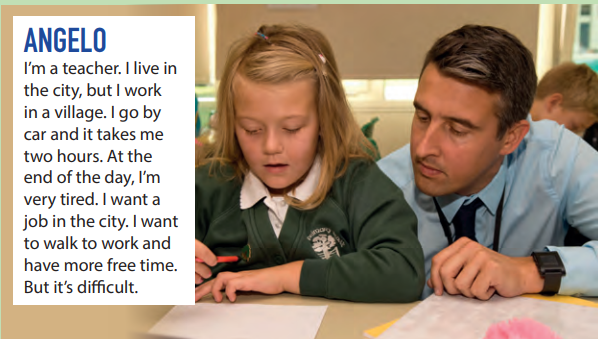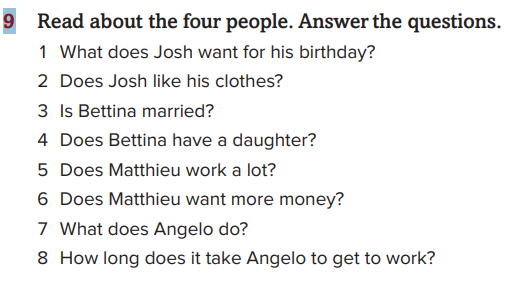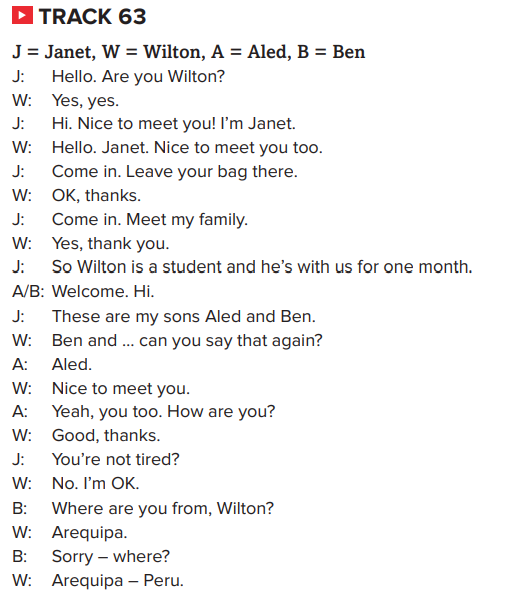Rereading texts to revise language at low levels
Rereading texts to revise language can be good because we access language outside the selection in exercises labelled vocabulary or grammar. Whether you have treated the listening or reading text as purely developing skills or not, there is good reason to revisit texts to focus on language – especially when we want to revise content later in the course and especially at low levels.
Rereading to improve reading fluency (and revise words)
In the case of lower levels, it can be good to reread a text to help with reading fluency – especially when your students are working with a new script. My own experience is that I remember struggling with the Cyrillic alphabet and reading at the start of my learning. Later when I looked back at some of the first texts I read, I realised I could read them far quicker. I recognised whole words, and even where I had forgotten the meaning of something, I could process the letters and ask about it better. You might encourage students to regularly record themselves reading out a text. They might reread it some weeks later and see if they can do it quicker. As Grabe and Yamashita note in their book second language reading, there is a positive correlation between reading fluency and comprehension.
Note though, that greatest constraint on fluency in reading is word knowledge. Rereading to revise language does work to a limited extent, but if we want language revision activities to be more effective, we should include more recall practice. Furthermore, as we suggest in Teaching Lexically and in our previous post, the language that we want to teach and revise is grammaticalised phrases and collocations. This will help reading fluency as students become used to parsing and processing larger chunks of text rather than word by word.
Including recall when rereading to revise language
At low levels, texts should be more focused on fairly generic topics and conversations. It is often possible to make changes to the text, for students to see how these routines can be varied and also introduce some recall into the rereading activity. So for example, Take this text from an early unit of our book Outcomes Beginner (National Geographic Learning),

We could rewrite this text like this:
I’m a shop assistant. I live in a village with my parents, but I work in the city. I go to work by bus and it takes me more than an hour. At the end of the day, I’m really tired. I would like to move to the city, so I can walk to work and have more free time. But it’s difficult. Renting a place in the city is very expensive.
In class, the teacher reads out the ‘new text’ and students listen and note what they hear (they can use L1). They then re-read the old text and identify five things that are different. In pairs, they reconstruct the teacher’s new text. They could do this the other way round – students listen to the original text (in outcomes it is recorded) and read the new one.
Not just revision but elaboration
In the new text above I have changed some aspects of grammar (without changing the meaning) and added a piece of information. This recycles other language students learnt OR provides something new to learn. As I suggested previously, revision can – and perhaps should – include some new items. We could follow up this revision activity by getting the students to rewrite Angelo’s text from memory and add some information of their own. You might ask the students questions (again, revising language!) to prompt them: Who does he live with? In what kind of place? Why is it difficult to get a job in the city?
Using comprehension questions to recall and reconstruct texts
A second way to revise the language from a text at low levels, is to give students the comprehension questions (such as those we see below from Outcomes Beginner).

Show them WITH THE ANSWERS. Students may have these written in their books anyway, or you could give them using a whiteboard presentation tool. The students then work in pairs and try to re-write the texts using this information. They can then compare and adapt in groups, before comparing with the original text and saying what they found was different.
Text-based revision – gapping words
The classic way to get students to revise language from a text is simply gapping words. And it’s a classic for a reason, because it does force the students to recall language rather than just read. Publishers often provide word docs of the texts which you can adapt and then project on the board, if you don’t want to make photocopies. If you don’t have a projector or photocopier you could dictate the text and just say where the spaces are, or get students to write the next two words. As with other activities to revise language it’s good to focus on gaps that aren’t single words. The gaps might focus on collocations or an aspect of grammar. So we might have a text like this:
I only work for two days ….. ….. – fifteen ….. ….. hours. I ….. ….. a lot of money, but I don’t want ….. ….. of things. Money’s ….. ….. to me. I have food. I ….. ….. water. I have friends. I have some books ….. …… . I have a lot of ….. ……
Revising routine conversation – gapping questions
When revisiting a listening text like the one below, we might gap the questions in the dialogue or common chunks you see in replies. If you want to make things a bit easier with larger chunks you might add the first letter of each word.

Follow-up discussions to revise language
In Outcomes, as with other coursebooks, there are usually some simple discussion questions in the coursebook. Students could discuss these again on the assumption that they may be able to add to their original answers now they have more language. Or you may be able to ADD questions about the text that weren’t previously possible because of the students’ lack of language. Here for example, we might be able to ask:
- Are the people similar to you in any way? In what ways?
- Which situation is more common in your country?
- Is money important to you? Why / Why not?
- What things are most important to you?
Once again, we might expect these questions both to revise language students have learnt, but also potentially get them to go beyond that. They can look up this new language or ask you to help them say more.
Text-based revision activities at higher levels
These tasks stick quite closely to the original texts and are more about repeating common routine conversations (What do you do, where do you live?, How are you etc.). As we discuss in our forthcoming zoom courses on getting the most form your coursebook and teaching listening better, at higher levels you might want to shift the focus. When we revisit texts you might want to focus more on working with the vocabulary in the text and generating old (and new) language that is connected to those words.
Book a zoom course with us this week and you will get a free course based on our webinar series on Teaching Speaking Skills.
what does this ( Show them WITH THE ANSWERS. Students may have these written in their books anyway, or you could give them using a whiteboard presentation tool. ) mean?
The illustrated extract is the comprehension questions as they appear in the coursebook. I am assuming (as this is revision) that the students have done this text and and have the answers written in the books. However, some students may not have done this or perhaps you are using a classroom presentation tool on an interactive whiteboard. In this case you will need to show the students the answers again (not the text!). It’s from these completed answers that the students will try and reconstruct the text. Apologies if this was unclear and I hope that helps. The revision task might happen in the following lesson to when they did the reading or several weeks later.
Great ideas- simple, effective, and low prep for teachers. Thank you.
It’d be interesting to know how these tasks should be adapted for intermediate and more advanced levels.
I think in practice, few of these tasks are directly adaptable to higher levels, because the nature of language and students’ needs change as they develop. For intermediate students I think recording themselves reading aloud and try to improve their reading rate still has value. Gap fills could also obviously work. I’m not sure how far the r-writing of text will work at higher level because it really relies on either a strong genre or routine. It would probably work for a writing text like a PET/FCE type essay or email/letter. That kind of thing. It might also work for a vocabulary exercise based on single sentences, where the changes you make might be focused on highlighting and varying a chunk. More generally, at intermediate levels I would tend to focus more on mediating / responding to texts, noticing vocabulary, different ways to practice/talk about the text, retelling texts. At advanced levels, translation and discussing translations might be play a bigger role. We look at these kinds of exercises in our courses Plan smarter …/ Mediation in language teaching and our Summer training course in London.